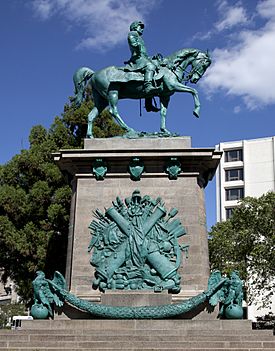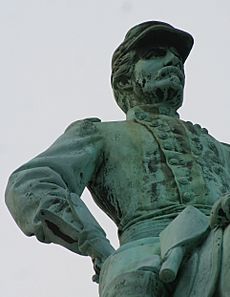Equestrian statue of George B. McClellan facts for kids
 |
|
| Coordinates | 38°55′00″N 77°02′47″W / 38.916667°N 77.046389°W |
|---|---|
|
Equestrian statue of George B. McClellan
|
|
|
U.S. Historic district
Contributing property |
|
| Part of | Civil War Monuments in Washington, D.C. |
| NRHP reference No. | 78000257 |
| Added to NRHP | September 20, 1978 |
| Location | Intersection of California Street, Columbia Road and Connecticut Avenue NW, Washington, D.C., United States |
| Designer | Frederick William MacMonnies (sculptor) James Crocroft (architect) Edmond Gruet Jeune {founder} |
| Material | Bronze (sculpture) Granite (base) |
| Length | 9.5 feet (2.9 m) |
| Height | 31.6 feet (9.6 m) |
| Opening date | May 2, 1907 |
| Dedicated to | George B. McClellan |
The Major General George B. McClellan statue is a famous equestrian statue in Washington, D.C.. It honors George B. McClellan, a key general during the American Civil War. This monument stands in the Kalorama Triangle Historic District neighborhood.
The statue was created by American artist Frederick William MacMonnies. He was chosen after a big competition. The monument was officially opened in 1907. Important people like President Theodore Roosevelt and McClellan's son, George B. McClellan, Jr., were there. Thousands of military members also attended.
This sculpture is one of eighteen Civil War monuments in Washington, D.C. All these monuments were added to the National Register of Historic Places in 1978. The bronze statue sits on a tall granite base. This base has cool emblems and bronze reliefs (carvings). A small public park surrounds the statue. The National Park Service takes care of the monument and the park.
Contents
History of the McClellan Statue
Who Was George B. McClellan?
George B. McClellan (1826–1885) became a major general during the American Civil War. He was known for organizing the Army of the Potomac. This was a very important Union Army. Even though he had some tough battles, his army's victory at the Battle of Antietam helped stop the Confederate invasion of the northern states. Later, President Abraham Lincoln removed him from his command. After the war, McClellan served as the 24th Governor of New Jersey.
Planning the Monument
After General McClellan passed away in 1885, a group of Union veterans called the Society of the Army of the Potomac wanted to build a monument for him. In 1901, the U.S. Congress gave $50,000 to build the statue. A special commission was then formed to manage the project. They decided the monument should be an equestrian statue, meaning McClellan would be shown riding a horse.
In 1902, a design competition was held. Many sculptors submitted their ideas. However, the commission wasn't happy with any of the designs at first.
In August 1903, the commission chose Frederick William MacMonnies to create the statue. MacMonnies was a talented American artist who lived in Paris. He had studied art and worked with famous sculptors. His other well-known works include a statue of Nathan Hale in New York City. MacMonnies created a new design that was approved by officials and McClellan's widow, Nelly. James Crocroft designed the monument's base, and Edmond Gruet Jeune cast the statue in bronze.
Choosing the Location
The place for the monument changed several times during the planning. Many spots were suggested. In 1906, people living in the Kalorama Triangle Historic District neighborhood asked the commission to put the statue there. This area was once a Union camp in 1861 when McClellan first arrived in Washington, D.C.
The commission, led by Secretary of War William Howard Taft (who later became president), agreed. They felt this spot at the intersection of Connecticut Avenue and Columbia Road NW was "more satisfactory and imposing."
Dedication Ceremony

The monument was officially dedicated on Thursday, May 2, 1907. Before the ceremony, about 700 veterans marched in a military parade to the dedication site. The area around the monument was decorated with flags and flowers. The statue itself was covered with two American flags.
Many important people attended the event. President Theodore Roosevelt was the main speaker. McClellan's son, George B. McClellan, Jr., who was then the mayor of New York City, also attended. Other guests included politicians, generals, and thousands of citizens.
McClellan, Jr. unveiled the statue, and the crowd cheered. The Fourth Battery of the Field Artillery fired a salute, and the Marine Band played "The Star-Spangled Banner." After a military parade, President Roosevelt gave a speech. He praised the statue and the sculptor, saying it added to the "nobility and beauty of the capital city." Other generals also spoke about McClellan. The ceremony ended with the band playing "My Country, 'Tis of Thee."
Later Years and Restoration
The McClellan statue is part of the group of Civil War monuments listed on the National Register of Historic Places in 1978. It is also a key part of the Kalorama Triangle Historic District. The National Park Service owns and maintains the monument and its park.
In 2009, the monument had a big restoration project that cost $114,000. This was the first major cleaning and repair of the statue since it was dedicated in 1907. Workers cleaned, painted, and waxed the statue. They also fixed damage, like removing spray paint from the base and repairing water leaks inside the horse's legs. A missing bronze shield was also replaced.
Design and Location
The monument stands in a very noticeable spot where California Street, Columbia Road, and Connecticut Avenue NW meet. It is on the southern edge of the Kalorama Triangle Historic District. The statue faces south, looking down Connecticut Avenue towards Dupont Circle and downtown Washington, D.C. A small public park surrounds it. Nearby buildings include the Churchill Hotel and the Washington Hilton.
The bronze statue itself is 13.6 feet (4.1 m) tall. It shows McClellan in his Union Army uniform, complete with a hat, sash, and sword, riding his horse. He holds the horse's reins with his left hand, and his right hand is on his hip.
The granite base is 18 ft (5.5 m) tall and 9.5 ft (2.9 m) long. It sits on an even larger base that is 44 ft (13 m) long and 30 ft (9.1 m) wide. Near the top of the granite base, there are eight shield-shaped emblems. These shields list important Civil War battles that McClellan led, such as Antietam and Yorktown. On the sides of the base, there are bronze reliefs showing cannons, eagles, flags, and swords. A bronze oak and laurel garland (a decorative wreath) runs along the bottom of the pedestal, with bronze eagles at each corner.
The monument also has inscriptions:
- On the front of the pedestal: MAJOR GENERAL / GEORGE BRINTON MCCLELLAN / 1826–1885
- On the back of the pedestal: ERECTED BY THE / GRAND ARMY OF THE POTOMAC / AND THE / CONGRESS OF THE VNITED STATES / 1907
- On the left side relief: MAC MONNIES / E. GRUET JNE FONDEUR
See also
 In Spanish: Estatua ecuestre de George B. McClellan para niños
In Spanish: Estatua ecuestre de George B. McClellan para niños



